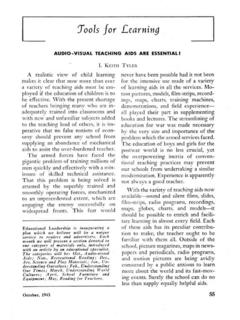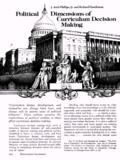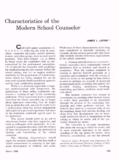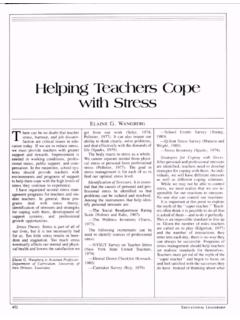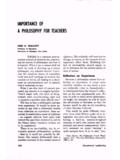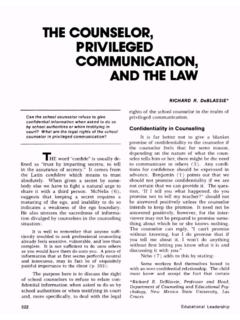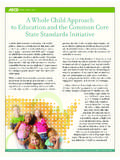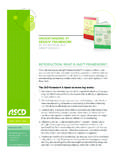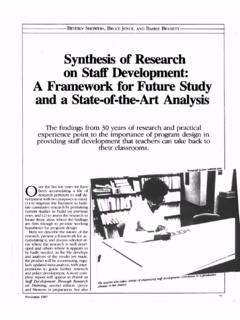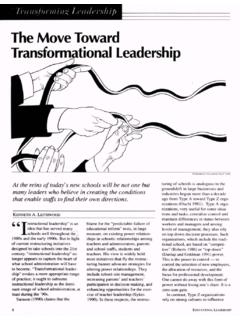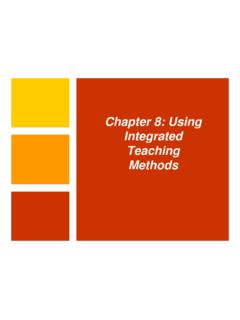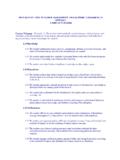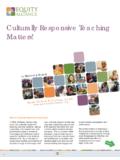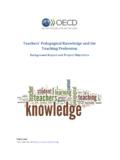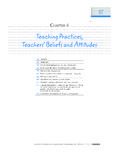Transcription of Teaching Reading in Social Studies - ASCD
1 Teaching Reading in Social Studies A Supplement to Teaching Reading in the Content Areas Teacher's Manual (2nd Edition). Jane K. Doty Gregory N. Cameron Mary Lee Barton Mid-continent Research for Education and Learning 2550 S. Parker Road, Suite 500, Aurora, CO 80014-1678. Phone: Fax: 2003 McREL (Mid-continent Research for Education and Learning), Aurora, Colorado. All rights reserved. This publication, while not directly funded by the Institute of Education Services, Department of Education, draws on the work of projects previously completed under contract numbers RP91002005 and R319A000004B; specifically, Teaching Reading in the Content Areas: If Not Me, Then Who?
2 , Teaching Reading in Mathematics, and Teaching Reading in Science. The content of this publication does not necessarily reflect the views of the Institute of Education Services, the Department of Education, or any other agency of the Government. To purchase additional copies of this book, contact Association for Supervision and Curriculum Development 1703 N. Beauregard St. Alexandria, VA 22311-1714 USA. Telephone: or Fax: Web site: E-mail: ascd Stock number #303357. ISBN 1-893476-07-3. Prices: ascd member, $ ; nonmember, $ Discounts for bulk purchases are available. Table of Contents Acknowledgments.
3 Ii About the Authors ..iii Section 1: Three Interactive Elements of Reading ..1. The Role of the The Role of Climate ..10. The Role of Text Features ..18. Text Features: Vocabulary ..18. Text Features: Text Style ..25. Section 2: Strategic Processing ..37. Section 3: Strategic Teaching ..45. Section 4: Six Assumptions About Section 5: Reading Vocabulary Development ..78. Narrative Text ..105. Informational Text ..110. Reflection Strategies ..150. Workshops Available ..178. i Acknowledgments The authors extend a special thanks to the many contributors to this publication. In particular, we would like to acknowledge Mid-continent Research for Education and Learning staff members, specifically Linda Brannan and Terry Young, who helped with the literature searches and copyright permission; Clare Heidema and Chris Snyder for quality assurance review; Diane Paynter and Salle Quackenboss for reviewing the content and providing feedback; Judy Counley and Marla Fultz, who performed the graphic and desktop publishing portion; and editor Vicki Urquhart.
4 We also would like to acknowledge outside reviewers Maria Foseid and D. Mark Morgan. Our utmost appreciation goes to Mary Lee Barton, Clare Heidema, and Deb Jordan for the work they did on Teaching Reading in the Content Areas: If Not Me, Then Who?, Teaching Reading in Mathematics, and Teaching Reading in Science. Their documents have provided many teachers with explicit strategies and practical suggestions. ii About the Authors Jane K. Doty, , Jane K. Doty, a lead consultant for McREL, consults and trains nationally and internationally with teachers, curriculum developers, and school administrators as they implement standards-based approaches.
5 She also has conducted training in the Teaching Reading in the Content Areas series, Classroom Instruction That Works, and Dimensions of Learning. Prior to joining McREL, Jane worked as a classroom teacher for 16 years. She earned her from Keuka College, her from Plattsburgh State University, and her (Certificate of Advanced Study) from Oswego State University. She is one of the authors with Dr. Robert Marzano and Diane Paynter, of the Pathfinder Project, an inspirational and motivational curriculum designed to engage students in learning. She can be contacted at Gregory N. Cameron, As a senior consultant for McREL, Gregory N.
6 Cameron provides a variety of research- based services in the areas of leadership, comprehensive school reform, standards-based curriculum, and professional learning communities to schools, districts, and state departments of education nationwide. He earned his from the University of Colorado and his from the University of Denver. Prior to joining McREL, his 14. years of experience included Teaching Social Studies at the middle and high school levels;. developing a K 12 standards-based Social Studies curriculum; and serving as an elementary school principal in Colorado. He can be contacted at Mary Lee Barton, Ed.
7 Mary Lee Barton has worked in the areas of literacy, learning, and professional development for more than 25 years. Co-author of Teaching Reading in the Content Areas: If Not Me, Then Who? (2nd Ed.) and its supplements, Teaching Reading in Mathematics and Teaching Reading in Science, Mary Lee has facilitated literacy training seminars for thousands of teachers across the United States and Canada. She also has written articles for Educational Leadership, the NASSP Bulletin, and other McREL publications. With Dr. Robert Marzano, she co-authored ascd 's Helping Students Acquire and Integrate Knowledge.
8 Mary Lee can be contacted at iii Three Interactive Elements of Reading Reader Climate Text Text Vocabulary Features Style Text Audience Structure Appropriateness Text Coherence Strategic Processing Metacognition Cognition Motivation Strategic Teaching Six Assumptions About Learning Learning is: 1. Goal-oriented 2. The linking of new information to prior knowledge 3. The organization of information 4. The acquisition of cognitive and metacognitive structures 5. Nonlinear, yet occurring in phases 6. Influenced by cognitive development Strategies Vocabulary Narrative Informational Reflection Figure 1.
9 Model of Teaching Reading in the Content Areas iv Rationale The primary purpose of Social Studies is to help young people develop the ability to make informed and reasoned decisions for the public good as citizens of a culturally diverse, democratic society in an interdependent world.. National Council of Social Studies Working with students to help them gain the knowledge and skills necessary to become informed decision makers in a democratic society is a powerful responsibility. The study of Social Studies is much more than memorizing historical facts;. geographical statistics; or government, civic, and economic terminology.
10 It is really about problem solving, decision making, reflective inquiry, and critical thinking. More than any other academic area, it is about helping students become strategic thinkers responsible for decisions that impact our society. They must be strategic in their Reading and be able to comprehend and use what they read to make informed decisions and choices in the world in which they live. Consider the story of a teacher's encounter with the parent of a first grade student: The week before school began the parent brought her daughter to meet the teacher. The parent proudly stated to the teacher that her daughter was quite bright and could already read.
